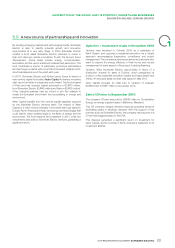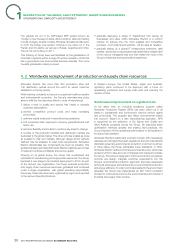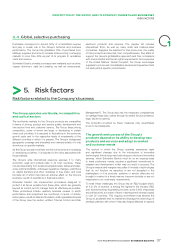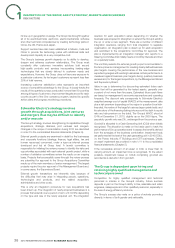APC 2010 Annual Report Download - page 36
Download and view the complete annual report
Please find page 36 of the 2010 APC annual report below. You can navigate through the pages in the report by either clicking on the pages listed below, or by using the keyword search tool below to find specific information within the annual report.
DESCRIPTION OFTHEGROUP, ANDITSSTRATEGY, MARKETS ANDBUSINESSES
1ORGANISATIONAL SIMPLICITY ANDEFFICIENCY
>
4. Organisational simplicity
andefficiency
The reorganisation of the Group has naturally led Schneider Electric to adapt its organisation so as to have a focus in
line with its strategic importance at any time, in any country and in any business.
The implementation of the new organisation was fi ne-tuned in early 2011, and was accompanied by a wide-ranging
corporate culture initiative.
Designed for introduction alongside the reorganisation, the One company program has, in particular, facilitated the
rapid integration of acquisitions, notably that of Areva’s distribution arm, which led to the creation of the Group’s
Energy business. It is also contributing to the establishment of a common corporate culture within the Group.
4. 1 An organisation focused on end markets
The change in organisation was designed to accelerate the impact
of the One company program. The new organisation will support
each of the three transformations introduced by the One program:
•fi rst, the change needed to make Schneider Electric “1 Solution
Provider” was accelerated by the creation of fi ve businesses with
responsibility for providing innovative solutions in their key end-
customer segments by using R&D resources dedicated to their
product lines and specialised sales forces;
•second, to make Schneider Electric “1 Leader in New Economies”.
This will be facilitated by the globalisation of support functions
and deployment of specifi c strategies for new economies by
each of the fi ve businesses;
•third, to make Schneider Electric “1 Company”. To a great extent,
this will be facilitated by the pooling of local back-offi ce operations
and deployment of “Global Functions” that increase experience
and generate economies of scale.
Dual responsibility – products and customers
Schneider Electric’s organisation has become more streamlined
and is structured around fi ve businesses. Each of the businesses
has a dual responsibility in terms of its product lines and end-
customer segments.
This dual responsibility is a key factor in Schneider Electric’s
ambition to excel simultaneously in two areas: selling products,
which requires clear technological leadership, and selling solutions,
which means building close customer relationships and acquiring a
detailed understanding of end users’ needs.
This shift towards solutions is a major focus of the One company
program.
Each of the fi ve businesses manages its R&D, Marketing and Sales
teams and has responsibility for its global results.
A number of back-offi ce functions such as fi nance, human
resources, IT systems and marketing are handled by the Global
Functions, which have a governance role and provide services
internally.
The acquisition of Areva’s Distribution business has led the scope of
the fi ve businesses to be modifi ed from 2011:
•Power includes low voltage, installation systems and control,
renewable energies and the two end-customer segments (Marine
and Residential);
•Energy combines the activities of Areva’s Distribution business
and the medium voltage activities of Schneider Electric (previously
part of the Power business) with two end-customer segments
(Utilities and Oil & Gas);
•Industry, which includes automation and control and three end-
customer segments: OEMs, water treatment and mining, minerals
and metals. It now also includes CST, a mainly technological
business focused on customers in the automobile, aeronautics
and manufacturing industries;
•IT, which covers critical power and two end-customer segments:
data centres and fi nancial services;
•Buildings, which includes building automation and security
and fi ve end-customer segments: hotels, hospitals, life science
facilities, stores and “green” offi ce buildings.
2010 REGISTRATION DOCUMENT SCHNEIDER ELECTRIC34
























